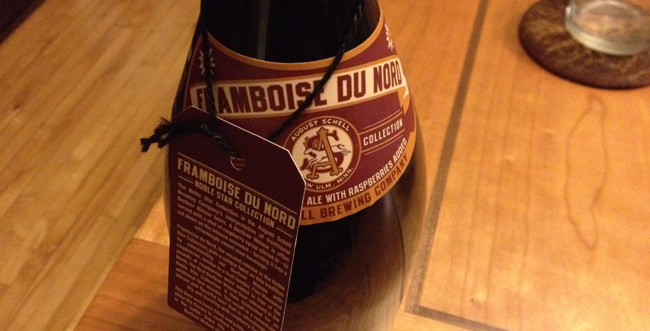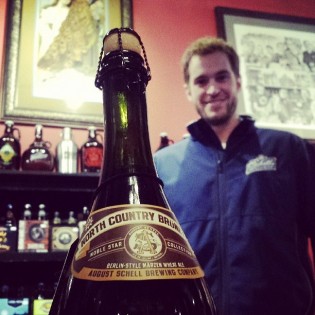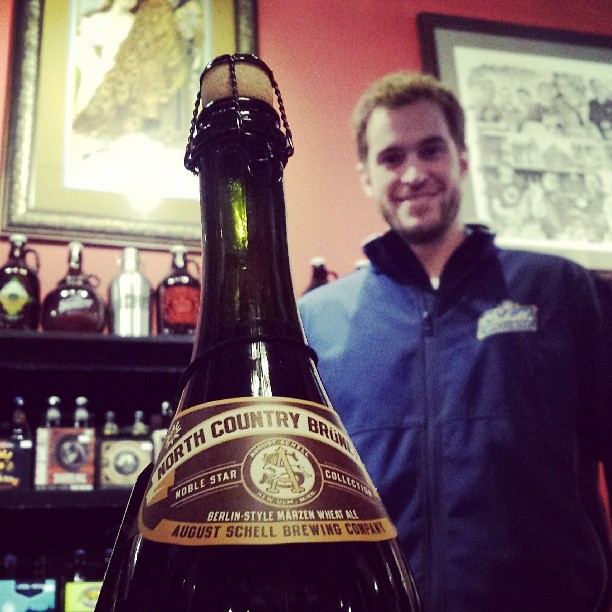
Among the flood of craft beers labeled “triple” this and “imperial” that, Schell’s beer suffers from an image problem — the brewery’s classic German recipes, historic brewing facility, and part-of-the-landscape image continue to evoke the original product which debuted in the 19th Century. Quietly, however, Schell’s beer has been expanding and growing — observant drinkers have noted that Schell’s isn’t just grandpa’s Deer Brand anymore, as the brewery now offers 20 different beers in production.
As part of the brewery’s campaign to wave its banner amid a flood of upstarts, Schell’s entered its Firebrick Vienna Lager, a beer they have been brewing for decades, into the World Beer Cup for the first time this year and earned gold.
Schell’s current President, Ted Marti, and son, Jace, represent the fifth and sixth generations of the Schell family. It was Ted and Jace who decided to refurbish long-defunct cypress lagering tanks from 1936 in order to launch a traditional German sour beer line. The lengthy process, which began in 2008, involved barrel restoration experts from The Barrel Room and Black Swan Cooperage, plus more than a little patience — the first beer, the Star of the North, was not ready until last summer.
These sour beers are grouped into the Noble Star Series and include a traditional Berliner Weisse, made with two-thirds wheat, as well as the same tart beer aged on raspberries, called Frambiose du Nord. Berliner Weisse was historically dubbed the “champagne of the north” by Napoleon and his troops in reference to its crisp, effervescent, and tart character. It is fairly low in alcohol and moderately sour. The latest Noble Star is the North Country Brunette, brewed in a nearly obsolete style called Marzen weisse. Once common before World War Two, the recipe all but died apart from a few dedicated and traditional brewers.
Marzen weisse is one of Jace Marti’s favorite styles and he was eager to try his hand at one after discovering the historic brew while training in Germany. It uses the same malt ingredients as an Oktoberfest but is then lagered and aged in the cypress tanks, which were inoculated with lactobacillus and brettanomyces, two microorganisms that, when carefully curated and kept in balance, create the sour character. The North Country Brunette is a balance of sweet and bready German malt with a sour flourish that sings through the finish and cleans the palate. It is a unique combination that would appeal to those who want to attempt sours without the harshness of lambics or gueuze.
The market for sour beer is expanding while more and more drinkers are also choosing local beverages. However, the local selection of sour beer is seriously lagging behind. Compared to other regions, such as southern states where sour beers are quite common and highly sought after, Minnesota can claim very few sour beers. On the more barnyard-funky side is the limited Surly Pentagram, a dark and sour elixir that is only available for a few days a year. The Wolf Brewing Berliner Weisse, from the revived Joseph Wolf brewery, is more widely available but displays less sour character.
Three more beers in the series are currently in the tanks, aging. The process is long, and Jace (pictured at left) describes how the beers seem to get worse in flavor before they get better. It requires tasting and tweaking along the way, but mostly it requires patience. The next to be released is the Marzen weisse on Oregon cherries, but it will not be seen for several months.
 I asked Ted Marti the question that he must be constantly responding to, whether in conversation or in his management of the brewery: how has Schell’s managed to stay relevant while surrounded by the new wave of craft beer? His response was poignant.
I asked Ted Marti the question that he must be constantly responding to, whether in conversation or in his management of the brewery: how has Schell’s managed to stay relevant while surrounded by the new wave of craft beer? His response was poignant.
“As the water rises, all the boats float higher.”
He goes on to describe the influx of beer as a cycle. “We are all competitors,” he says, “but right now it is at a peak. We are all getting along and growing.” Jace adds, “the American craft beer movement is variations on English styles like IPA. And Belgians. But we have always done German and American lagers. That is what we do.”
Schell’s has the local lager market cornered. Apart from Firebrick, they brew several other award-winning lagers. They may have more competition as the lager, previously unfashionable, becomes the target of new breweries such as Bauhaus, soon to open in Northeast Minneapolis.
Other changes this year include sampler packs of classic styles revisited, an idea launched by head brewer Dave Berg. The first edition featured pilsners and it flew off shelves in March. The iterations were the original 1984 recipe, pilsner with Mandarina hops, the current recipe, and one with added rye malt. Look for their upcoming sampler of hefeweizens in July, including a rare dampfbier, a style seldom brewed locally and currently only found at Surly.
Without a doubt, those at Schell’s plan to keep their heads down and continue with hard work, uninterrupted, as they have done for the past 150 years. Adding things along the way, such as the North Country Brunette, only serves to expand their influence in the local market.

